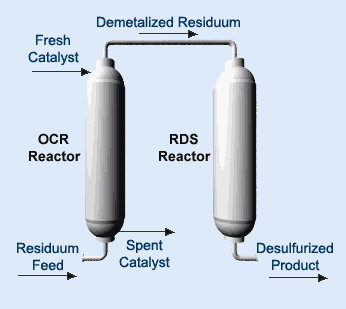OCR
Moving Bed Technology for the Future
CLG’s On-stream Catalyst Replacement (OCR®) process is a countercurrent, moving bed reactor that enables refiners to significantly increase capacity and improve product quality from a fixed bed RDS reactor. The high pressure, high temperature OCR reactor can be added to the processing scheme either before or after the fixed bed RDS unit. When adding an OCR reactor in front of the RDS unit, refiners can increase feed throughput and/or process heavier feeds with higher levels of contaminant metals, while maintaining excellent product qualities and economical fixed bed run lengths.
OCR enables refiners to process resids with more than 400 ppm metal (Ni + V) or to achieve deeper desulfurization when processing low metal feeds. In either case, the life of the downstream catalyst is improved substantially and problems from pressure drop buildup are reduced.
 After thousands of transfers, the catalyst movement system has proven to be simple, safe and highly reliable. Since catalyst transfer is a batch operation (typically once or twice a week), the system is generally used with at least two fixed bed reactors as well as the OCR unit. Catalyst transfer in and out of the OCR reactor is accomplished with no interruption in the processing scheme.
After thousands of transfers, the catalyst movement system has proven to be simple, safe and highly reliable. Since catalyst transfer is a batch operation (typically once or twice a week), the system is generally used with at least two fixed bed reactors as well as the OCR unit. Catalyst transfer in and out of the OCR reactor is accomplished with no interruption in the processing scheme.
How OCR works
The OCR reactor adds fresh catalyst and removes spent catalyst from a high pressure reactor while the unit is on-stream.Fresh catalyst is added at the top of the reactor while residuum is fed into the bottom. Both catalyst and feed move through the reactor in a countercurrent flow, causing the dirtiest residuum to contact the oldest catalyst first. The upflow of the residuum through the OCR reactor slightly expands the catalyst bed. This enhances residuum/catalyst contact, minimizes reactor plugging and creates a consistent pressure drop for optimum flow patterns.
Meanwhile, the fully spent OCR catalysts are removed at the bottom of the reactor.
Processing higher metal feeds
Either by crude changes or cutting deeper into the barrel, refiners have maintained and/or improved fixed bed run length and product quality.Producing ultra-low sulfur fuel
OCR minimizes the amount of fixed bed demetalation catalyst needed to protect the high activity desulfurization catalyst while maintaining consistent catalyst performance throughout the run.Preparing feed for the RFCC
OCR/RDS technology has provided excellent quality RFCC feed from a variety of heavy atmospheric residuum feeds, including Arabian Heavy and Ratawi, with no operating problems.Retrofit or grassroots OCR improves production economics
OCR’s efficient design can be easily integrated into existing refinery configurations. When retrofitting a fixed bed residuum hydrotreater with an OCR reactor, benefits may include the ability to:- Process less expensive heavy, high metals feedstock
- Increase the feed rate to the existing RDS/VRDS unit
- Increase product quality by operating the unit more severely
In grassroots installations, refiners can reduce overall construction cost and minimize future operating expenses by building smaller fixed bed reactors to achieve a given product target.
In either retrofit or grassroots installations, the investment cost of installing an OCR reactor and catalyst transfer equipment are more than offset by the savings realized in crude cost and in improved catalyst efficiency.